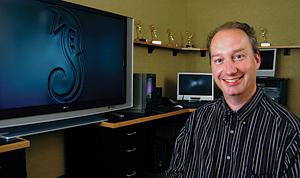Autodesk Smoke Speeds Production

Brian Mulligan
INDIANAPOLIS
We're a local broadcast station that uses Autodesk's Smoke product a bit differently than a post-production facility might.
We don't offline or conform EDLs or XMLs. We create from scratch, designing and editing directly with Smoke. We have two Smoke systems that are used for editing, effects and graphics for all of our on-air topical and image promotions, as well as commercial productions.
Long-form local programming and special news content also find its way into the system.
PRODUCING SPOTS IS A BREEZE
As we use Smoke for spot work, it has to excel at graphics and effects, and also has to be fast. I usually only have about eight hours to complete a 30-second promo or commercial, and often there is little to no video available. In most cases, I don't get to see the script until the morning of the project. And there's no set graphic design either. So I have to work on-the-fly a lot, which is typical for a broadcast station in this size market.
Smoke's fast editing and effects work, rendering that take only minutes, along with its fluid interactivity while designing are what makes it the best all around tool that I've used.
Everything I need is all there in one box; I never have to go out of the software to achieve the effects that I need. And that's not even taking into account the ease of actually editing inside Smoke. The timeline is in itself a powerful and easy-to-use editing and effects module.
Smoke has a 3D compositing environment called Action at its center. Once I finish a skeleton edit (basic video with no effects), I can then take individual clips or complete sequences into Action and then animate or composite them with other elements. These shots then nest back onto my timeline, where I can edit or reuse them in the current edit, or a new one.
For a recent "There's an App for that..." promo (which announced our WTHR-TV iPhone application), I used Action to create a motion graphics spot. The easy thing about this spot was that the iPhone UI screens were previously created in a layered Photoshop file by the application designers.
MORE THAN 50 LAYERS
With Smoke, I was able to import that PSD, and maintain the layer order and composition, while being able to animate every little button and element. It was then a matter of keyframing the icons and unique screens for news, weather radar, and traffic cameras—along with some video elements—to create a clean iPhone-style spot with energetic animations. The promo was produced in 1080i, and even with more than 50 layers, I was able to keyframe and preview animations easily and at full resolution.
Smoke gives me all the creative and editorial tools I need, without having to learn 10 other pieces of software, and the fluid design of the interface makes editing and effects a joy to perform. I'm not ready to call myself a "Smoke Artist" just yet, but Smoke does allow me to create what I want to create. If it ends up being art, then all the better.
Brian Mulligan is senior editor at WTHR-TV Indianapolis and has been editing for more than 20 years. He may be contacted atbmulligan@wthr.com.
For additional information, contact Autodesk at 800-869-3504 or visitwww.autodesk.com.
Get the TV Tech Newsletter
The professional video industry's #1 source for news, trends and product and tech information. Sign up below.
